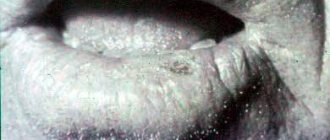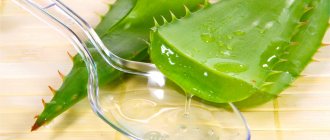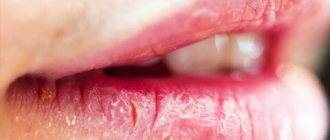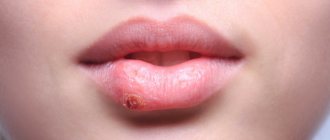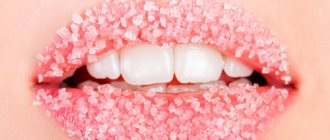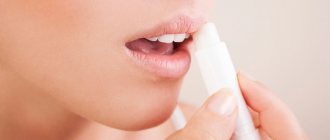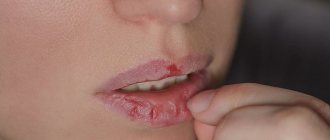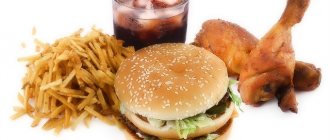Dermatovenerologist
Khasanova
Alina Rashidovna
9 years experience
Make an appointment
Patients often consult a doctor complaining of inflammation in the red border or mucous membrane of the lips. In most cases, a specialist diagnoses “cheilitis”. This is the name for tissue inflammation, which manifests itself in the form of redness, peeling, the appearance of purulent crusts and weeping ulcers. Any attempt to open the mouth when eating or communicating causes sharp pain associated with tissue damage. Without proper treatment, the disease persists for a long time, causing the patient a lot of physical and aesthetic inconvenience. For young people, the prognosis after clinical treatment of cheilitis is completely favorable, but older patients may encounter its complications in the form of leukoplakia and the onset of the oncological process.
Reasons for development
In the clinical practice of most specialists, there are cases where cheilitis on the lips developed on its own or was a side effect of a serious disease of the internal organs or damage to the mucous membrane. Among the most likely causes of the development of the disease are:
- inflammation of the mucous membrane with dermatoses, erythematoses or lichen planus;
- infectious diseases: syphilis, tuberculosis, etc.;
- psoriasis and other skin problems.
Among the unfavorable external factors, it is worth noting an excessive amount of ultraviolet radiation, strong wind, flows of cold or hot air from climate control equipment or ventilation in industrial premises. Signs of cheilitis are often observed in people who work in open areas in direct sunlight.
A separate group includes manifestations of allergic cheilitis, which developed after contact of the lip mucosa with aggressive chemicals or prolonged exposure to ultraviolet radiation. Sometimes doctors observe the clinical picture of secondary cheilitis, when the development of the disease is caused by eczema, neuritis of the facial nerve, pathologies of the muscles and tissues of the facial part of the skull.
Prevention
In order to avoid encountering this unpleasant disease, patients at risk are recommended to:
- be examined by a dentist at least once every six months and promptly remove sharp edges of teeth, tartar, and damaged dental crowns that injure the lip;
- dentures should be made only from high-quality materials to suit the individual characteristics of the patient’s jaw apparatus;
- give up bad habits that destroy your health;
- do not stay in the sun for a long time, use protective equipment, including oil-based lipstick;
- pay attention to and begin treatment of chronic diseases of the gastrointestinal tract, endocrine system, internal organs;
Follow a diet that excludes salty, spicy, sour and spicy foods, as well as very hot foods and drinks.
Symptoms and signs depending on the type of cheilitis
The accepted classification of cheilitis makes it possible to clearly establish the type and causes of the disease, as well as to identify the characteristic signs of the pathological process:
- Exfoliative cheilitis is localized on the red border of the lips. It has a clear gender link: it occurs more often in women. The main symptom is peeling of the lips due to neurological disorders: stress, depression, anxiety. Often the inflammatory process develops against the background of hyperthyroidism, or intense activity of the thyroid gland. The danger of exfoliative cheilitis is its ability to be inherited as a genetically fixed change in the body’s immune system.
A feature of exfoliative cheilitis is localization only on the red border of the lips, while the mucous membrane and skin around the mouth remain intact. In most cases, only part of the border is affected, while areas at the corners of the mouth usually retain their appearance. If a patient has dry skin, he often complains of tightness of the lips, the appearance of scales, and a burning sensation. It is almost impossible to completely cure exfoliative cheilitis. The disease proceeds along a sinusoid, sometimes exacerbating, sometimes disappearing under the influence of medications and external factors. Without medical supervision and if you refuse to take a course of treatment, large bleeding crusts form on the lips, which cause discomfort during conversation and eating.
- Glandular cheilitis develops against the background of pathological proliferation of the salivary glands. A humid environment creates favorable conditions for pathogenic microorganisms, as a result of which the mucous membrane becomes easily infected. If the pathology of the salivary glands is congenital, the probability of developing glandular cheilitis is 100%. The risk group also includes patients with dental problems: untreated caries, periodontitis, tartar, etc.
In some cases, glandular cheilitis develops as a result of damage from waste products and the breakdown of pathogenic microorganisms. The disease is more often diagnosed in patients over 30 years of age and is localized on the lower lip. Primary symptoms are dry lips and the appearance of painful cracks. Usually these symptoms are ignored, and attempts are made to combat them with local cosmetic products. Without treatment, the problem worsens: erosions and bleeding wounds appear at the site of cracks. Involuntary licking of dry lips aggravates the pathological process, which leads to their further dryness.
- Contact allergic cheilitis is caused by exposure to an external allergen. This could be the chemical composition of lipstick, microorganisms on the surface of pencils or pens, which the patient is accustomed to often holding in his teeth during work or creative activities. Cheilitis is considered an occupational disease among musicians who are forced to hold the mouthpieces of instruments in their mouths for a long time. The symptoms of this type of pathology are quite common. Patients complain of itching, swelling, burning and inflammation of the lips. After prolonged contact with the allergen, blisters appear on the skin, the rupture of which opens small ulcers and erosions. In the chronic stage, the disease makes itself felt only with minor itching and peeling.
- Meteorological or actinic cheilitis is a reaction to weather conditions. For a sensitive organism, radiation, wind, cold or solar radiation are equally dangerous, provoking the appearance of characteristic symptoms: burning and itching, large crusts and erosion of the mucous membrane. With prolonged exposure to unfavorable climatic factors, the formation of small bubbles with liquid contents is possible. The dry form of cheilitis is considered the most dangerous for patients. Its first symptoms in the form of itching and burning are harmless. However, with prolonged development and lack of treatment, malignancy is possible - the degeneration of affected cells into a malignant formation.
- Atopic cheilitis is a type of skin disease: atopic dermatitis and neurodermatitis. The disease develops against the background of an allergic predisposition of the body, which reacts to cosmetics, perfumes, food and exposure to pathogenic bacteria. In addition to the usual symptoms, there is dryness and damage to the skin in the corners of the mouth, and intense peeling of the face.
- Hypovitaminous cheilitis develops against the background of a lack of B vitamins in the body. Patients usually complain of dryness and burning of the tongue and lips. Vertical cracks and small peeling scales are visible on the skin. The tongue increases in size, and teeth marks become visible on it.
Are you experiencing symptoms of cheilitis?
Only a doctor can accurately diagnose the disease. Don't delay your consultation - call
Gluten-free diet for thyroid diseases
This diet was first developed for patients who lacked an enzyme (peptidase) in their intestines that could break down gluten in grains. This is manifested by intolerance to a number of foods, diarrhea, bloating and abdominal pain after eating them. It was later found that the exclusion of foods with gluten restores the intestinal microflora during dysbiosis. This explains the improvement in the immune system.
In autoimmune thyroiditis, due to a genetic disorder of the immune system, lymphocytes perceive their thyroid cells as foreign and begin to destroy it.
Following a gluten-free diet helps reduce the titer (concentration) of antibodies to thyroid peroxidase and thyroglobulin. Therefore, her appointment is justified only if they are promoted. The minimum period for this style of nutrition to obtain results is six months.
Gluten is found in the following products:
- wheat grains, oats, semolina, rye, barley, pearl barley and barley grains
- sausage, canned meat and fish, frankfurters,
- beer,
- chocolate, ice cream, candy
- muffins, buns, cakes, pancakes
- marshmallows, store-bought marshmallows, jam, halva
- corn sticks, glazed flakes, chips
- mayonnaise, tomato paste, ketchup, ready-made salad sauces
- yogurt with filling, curd desserts, cheese curds, industrial curd mass
- margarine, all products similar to real ones - cheese, sour cream
- multi-component seasonings, soup concentrates, cubes and mixtures for preparing soups
- instant tea, coffee
- powdered and condensed milk,
- crab sticks
The following are considered safe to include in a gluten-free diet:
- brown, red and wild rice;
- buckwheat, millet;
- nuts (except peanuts);
- potatoes, carrots, pumpkin, cauliflower, zucchini, bell peppers, cucumbers, tomatoes, greens;
- beef, veal, rabbit, turkey;
- pike perch, carp, pike, hake, bream, cod, pollock, catfish, seafood, seaweed
- cottage cheese without additives, mild cheese, kefir, yogurt, sour cream;
- vegetable oil.
You should minimize the purchase of ready-made food, cottage cheese, and milk in the store. Fermented milk products must be prepared at home with the addition of lactobacilli and bifidobacteria, which are part of the starter culture.
If you purchase a packaged product, you need to carefully study its composition. Special gluten-free cereals are welcome; they can be purchased in specialized healthy (natural) food departments, but they are much more expensive than usual.
And here is more information about the treatment of hypothyroidism with folk remedies.
The diet for autoimmune thyroiditis is aimed at activating the formation of thyroid hormones when the stage of hypothyroidism occurs. It provides for a sufficient supply of protein and iodine, limiting calories due to saturated fats and simple carbohydrates. Dietary table 10c is recommended. When the titer of antithyroid antibodies increases, gluten-free diet is indicated to normalize the immune response.
Treatment of various types of cheilitis
The course is developed taking into account the type of diagnosed disease and the general condition of the body.
- For exfoliative cheilitis, additional consultations with a neurologist and neuropsychiatrist are recommended. The patient is prescribed a course of sedatives. Effective methods of local treatment include laser therapy, ultrasound or radiation therapy, and the use of moisturizing cosmetic creams and ointments. According to indications, hormonal medications and vitamin complexes are prescribed.
- Glandular cheilitis is removed with anti-inflammatory ointments. Local treatment consists of cauterization or desquamation of enlarged salivary glands, and during the rehabilitation period, the use of drugs to eliminate dryness or excess moisture of the mucous membrane.
- When treating atopic cheilitis, the goal is to eliminate any irritating factors. The local course is based on the use of anti-inflammatory and anti-allergic drugs in the form of external ointments. Patients are also recommended to have a hypoallergenic diet that excludes the consumption of fish, citrus fruits, spicy foods and alcohol.
- For meteorological cheilitis, treatment tactics include taking vitamin preparations, using local healing agents and ointments with a high UV filter.
Timely initiation of treatment and the patient completing its full course guarantees relief from the unpleasant symptoms of cheilitis with a long-term effect.
Diagnostics
The diagnosis of precancerous Manganotti cheilitis is usually made based on an external examination of the affected area and questioning the patient about the nature of the disease. In case of difficulties that may arise due to the similarity of the manifestations of this type of cheilitis with erosive and ulcerative forms of other diseases (herpes, leukoplakia, lupus erythematosus, lichen planus), analysis of scrapings from the damaged area of the lip will help. In addition, histological examination makes it possible to timely recognize the formation of cancer cells.
general information
Given the wide range of uses of corticosteroids for the treatment of various diseases, pharmacists have provided a sufficient variety of forms of these drugs:
- oral corticosteroids (for oral administration) – tablets, capsules;
- for injections - liquid preparations in ampoules;
- for local use (topical preparations) - ointments, creams, gels, liniments, powders;
- inhaled corticosteroids – aerosol, spray;
- nasal and intranasal agents – spray, nasal drops;
- for the eyes – eye drops.
Corticosteroids are hormonal substances produced by the adrenal glands to regulate metabolic processes.
In addition to the therapeutic effect, glucocorticosteroids can cause adverse reactions associated with suppression of immune activity and atrophy of skin tissue.
Such undesirable effects should be taken into account when using drugs in this group. In the production of ointment products, analogues of human hormones of synthetic origin and various additives are used to enhance the therapeutic properties.
Corticosteroid ointments can be divided into several types:
- Lungs - made on the basis of prednisolone or hydrocortisone;
- Moderate - based on prednicarbate, fluocortolone, flumethasone (Lorinden, etc.);
- Strong - these ointments are based on budesonite, mometasone, betamethasone, methylprednisolone and other corticosteroid hormonal substances (Elocom, Celestoderm B, Sinaflan, Beloderm, etc.);
- Very strong are flumethasone-based drugs (Dermovate).
There is also a separate group of products of mixed origin, to which, in addition to corticosteroids, additional active ingredients with antifungal or antibacterial action are added, for example, Flucinar, Lorinden, etc.
The drugs of these groups differ from each other in the intensity of their therapeutic effects, so they are selected in accordance with the severity of a particular skin disease.
